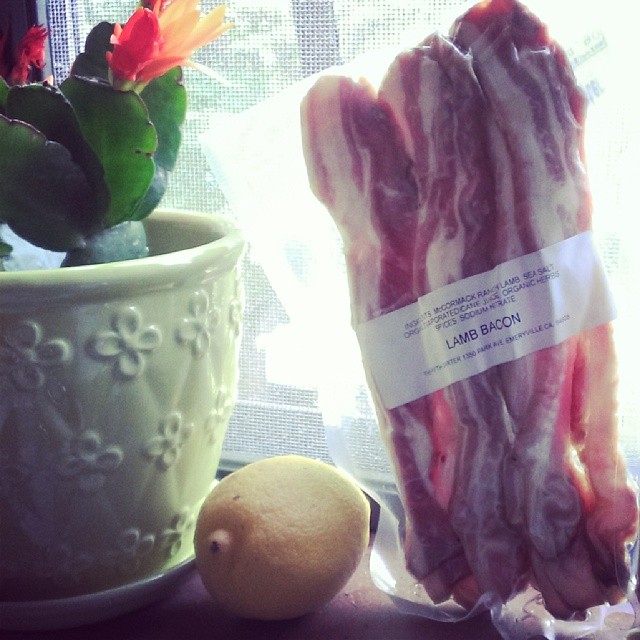Here's Why You Should Be Eating Lamb Bacon
Everyone knows about pork bacon. It's simply called bacon. But what about bacon made from other meats? Namely, lamb bacon, created from the belly of the sheep. It's smoked, cured and sizzled up into a fatty, meaty glory on par with its swine counterpart. "Lamb belly has more depth of flavor," says Ilan Hall of the Gorbals in Brooklyn. "I use lamb bacon because it has a gaminess that pork doesn't have, and it takes on smoke in a whole different way." As a bonus, lamb bacon is both kosher and halal, so you just might see it at your local Jewish or Yemeni deli. If you don't, ask if they'll order it for you.
Where it's from
The meat from the loin or breast of the sheep gets made into bacon, though you may see it called fatback, belly or saddle. If it comes from the saddle it's off the lesser-fat loin area, whereas belly bacon comes from the fatty underside and proves unctuous and rich (like pork belly). The taste of the meat offers a deeper, darker flavor that lends itself to Moroccan and Indian spices like cumin, coriander, turmeric, cinnamon and black pepper. You could say lamb bacon has a bit of mystery to it, making it special and unforgettable on first bite. "Lamb belly is the most lamb-y part of the whole animal, and the bacon has a very intense flavor. It gives a dish a very unique gaminess you can't get from another meat," says Paul Reilly of Denver restaurant beast + bottle. "A hog belly is so much thicker than a lamb's, and lamb bacon really has a much funkier, gamier flavor than pork bacon." Even those who aren't fans of lamb will likely get behind this cut as the fat works to ease up the meat's signature earthiness. That's why you'll find it popping up in butcher shops and elevated eateries across the country.
When it's in season
Many lambs are slaughtered in the spring, when the meat is tender and the animals are around 30 pounds. Though this is the best time to get fresh meat, you can really purchase it at any time since lamb bacon is preserved via curing and smoking.
What to look for
Lamb bacon looks surprisingly a lot like pork bacon, though it can be darker in color. You might see it at your local butcher shop and maybe in some farmers' markets, but it's unlikely you'd find it at a commercial grocery store.
How to store it
Make sure the meat is in a sealed container, either a plastic bag or secured well in cling wrap, and it will keep for a couple of weeks. For a longer life span, you can freeze the sealed bacon.
How to prepare it
You can cook this dish like you would any bacon and serve it in lieu of the pork kind in BLTs, as a side to scrambled eggs or diced up in potato soup. But if you really want to showcase the uniqueness of this meat, try it in a carbonara sauce, as Hall does. "I like to use lamb bacon instead of pancetta, or as I like to say, 'lambchetta,'" says chef Reilly. "Cooking it is essentially the same, but it cooks a bit faster because it's generally smaller and thinner." Bake it or put it in the frying pan and let it sizzle. "It provides a nice alternative to traditional pork bacon," says Hall. "Fun fact, but not the reason I love it: You can make it kosher."
Reilly has a whole-animal program, so when he gets a lamb in the shop he uses it to make his own bacon. This goes into breakfast sandwiches, gets mixed with gnocchi and ends up in other dishes depending on his whims. "We've also used it as an amuse-bouche because it's daintier and smaller than pork belly, and the aesthetics lend themselves to garnish purposes," he says. "We always have it on hand."



